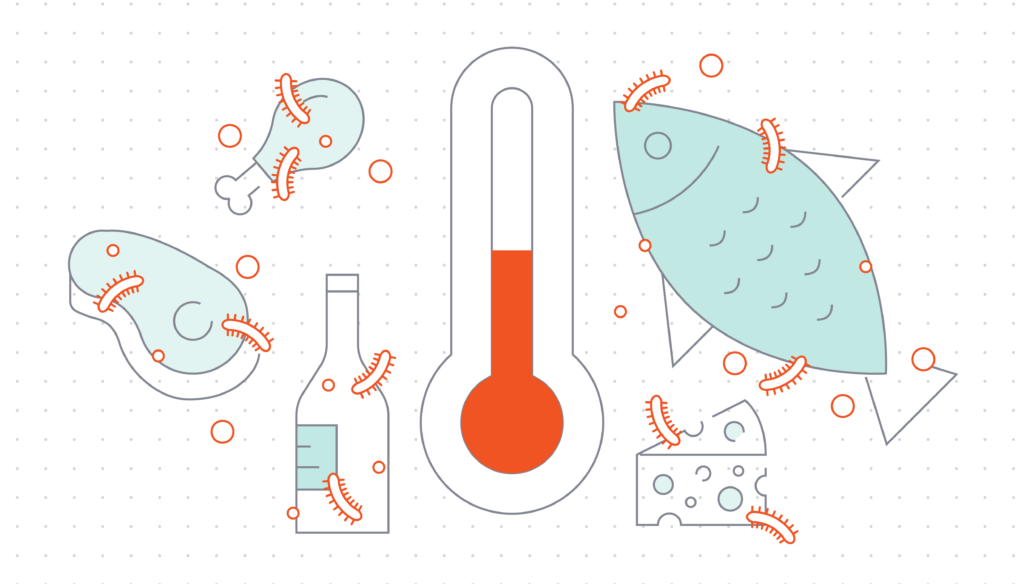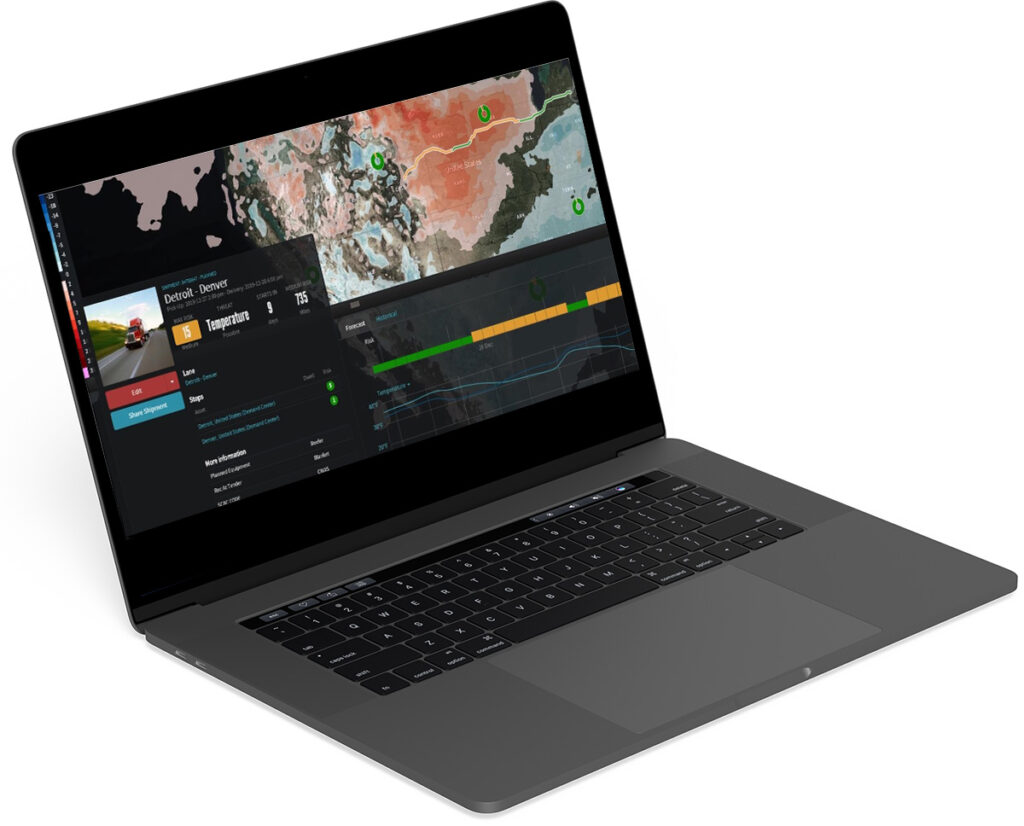Cold chain logistics serves to keep the temperature for goods at a constant throughout the storage and transportation phases of the supply chain. This intricate choreography is only possible with data-driven insights at every point in the process, from supply procurement through end customer receipt of goods. Here is how it works.
What is cold chain logistics?
Cold chain logistics (also referred to as chill chain logistics) is the transport of temperature-controlled goods, such as temperature-sensitive foods, beverages, and bio-pharmaceutical products. For companies who grow or manufacture these types of goods, delivering their products to the end customer is only half the battle. Ensuring the products are in good condition as expected upon delivery is critical and can often be challenging.
The cold chain process is more than just transportation. It impacts every step of the supply chain, from procurement through packaging, storage, and transport to end customer. The temperature-sensitive products must be kept at a consistent, specific temperature or within a temperature range throughout their lifecycle. A meaningful change of temperature during any supply chain phase can spell disaster for the goods, requiring remanufacture of any spoiled goods. A broken temperature chain can also have widespread negative impacts to customers, particularly with consumer products that are ingested.
Cold chain logistics involves correct packaging, proper transportation equipment, carefully chosen transportation routes, perfect timing, and visibility to ensure that what was expected is what happened.
Why is cold chain logistics important?
We often don’t consider how our foods, beverages, and medications are transported. We typically purchase them from local stores and pharmacies, unaware of how they got there. Yet, as manufacturing becomes more global and the demand for fresh, quality products increases, we are placing a giant bullseye on the cold chain logistics companies who must deliver those goods.
Growers, manufacturers, and suppliers of temperature-sensitive products, such as Alaskan seafood, dairy products, meats, frozen foods, wine, and certain medications, are taking heed. They understand how critical it is to keep these products at a set temperature for the duration of production and delivery timeframes. Some products can withstand temperature fluctuations, while others become unsafe with even the smallest deviation. While the end customer may not be able to notice the salmon they purchased at their neighborhood grocery store spent a couple of hours in a truck above 40°F, that deviation increases the risk for a foodborne illness. Fluctuations in temperature can reduce the shelf life of products from weeks to days.

This risk is exacerbated with certain chemicals and medications, such as many vaccines, antibiotics, and blood products. The Healthcare Distribution Management Association reports that approximately 10% of all medications are temperature sensitive, and that number may only increase in the coming years. Drug development is becoming more complex and, more frequently, involves large-molecule biologics that require precise temperature standardization to ensure efficacy.
Plenty is at risk when temperature-sensitive products experience environmental shifts. Quality, flavor, consistency, efficacy, and safety are all on the line. Cold chain logistics can help minimize the threat for such deviations and give these manufacturers and suppliers better control over their products every step of the way.
What are the challenges with cold chain logistics?
Cold chain companies are under increasing pressure to ensure goods are kept at specific temperatures, yet it is a constant challenge that only gets more complex with every passing year. “The sector is grappling with additional challenges – from increases in the sensitivity, quality standards, and volume of many of its goods, to continually mounting regulations. The cold chain also faces many of the same issues challenging the entire supply chain: service the global market, driving out costs, becoming more strategic, and addressing capacity and resource constraints, all while managing the exacting needs of the sector’s precious cargo – primarily good and pharmaceutical products,” said Inbound Logistics in a recent article on the top trends in cold chain logistics.
As consumers become more informed about their health and what they put into their bodies, they are demanding fresher foods and products, often from thousands of miles away. This raises a logistical challenge. Growers and suppliers of these fresh foods must find ways to bring their products to the consumer in the safest, fastest way that keeps the integrity of the product intact. With foods now sourced from all over the globe, this isn’t always easy.
The food industry isn’t the only one where temperature fluctuations in the supply chain can impact products. The pharmaceutical industry often brings to market temperature-sensitive medications that can range in their temperature requirements. These medications can travel from one end of the country to another and even a slight temperature deviation can cause an expensive, potentially life-saving drug to spoil before it ever reaches the patient. Even worse, if these temperature fluctuations aren’t strictly monitored and reported, the patient may still receive a compromised medication that can dramatically impact their treatment or even life. As such, pharmaceutical cold chain logistics involves as much or more oversight than that of the food and beverage industry.
How cold chain logistics works
Today, many logistical third-party companies are taking the cold chain enforcement burden off the manufacturer, at least when it comes to transporting their goods. These cold chain logistics companies provide specific expertise geared around transporting temperature-sensitive products. According to one source, “The potential to understand local rules, customs and environmental conditions, as well as estimation of the length and time of a distribution route, make them an important factor in global trade.”
The key to cold chain logistics is to integrate and control the various elements of the supply chain. This requires data and lots of it. This is not data that can be manually curated. There’s simply too much data to consider and it comes from too many potential sources. Furthermore, these data points are constantly changing. Instead, cold chain logistics companies are leveraging smart technology and data science to bring order to an often-chaotic process.
Data science is transforming the logistics industry, just as it is virtually every other industry. When used properly, it enables organizations to gather insights and visualize their shipping networks before anything is shipped. This valuable foresight allows decisions to be made with greater accuracy and better outcomes. The data is out there. Data science pulls it together in meaningful ways.

One such data source is the environment. The environment(s) which products will encounter directly impacts cold chain logistics. Using data gathered from historical and predictive weather models, cold chain logistics companies can calculate specific risks for each route and unique shipment. This data empowers transportation planners with the ability to make more dynamic decisions around transportation modes, shipment timing, and equipment or packaging selection in data-rich, intelligent ways.
The benefits of cold chain logistics data
Any organization which sells perishable goods must consider cold chain logistics as a primary factor in their ability to deliver quality products without compromise. The end user is not the only ones to benefit from temperature control. Companies can save thousands of dollars when they partner with a cold chain logistics company who gathers and leverages the right data.
While the value of maintaining the integrity of the shipment is evident, shipping using cold chain methods is expensive for companies trying to remain profitable. To do so companies must be smart in how they transport goods. Therefore, it is paramount that companies understand the products being shipped, their temperature tolerance(s), the shipping modes and lanes, the expected delivery dates, and the weather every step of the journey. There should be little-to-no unknowns, for those unknowns are precisely what brings about risk.
Cold chain logistics companies need to know the risk each shipment faces. Risks can be found in the weather, infrastructure, transit reliability, natural disasters, and other areas that threaten to interrupt or compromise the quality of a shipment. Until those threats are thoroughly understood and evaluated, they will cause surprises that can result in shipment delays, damage, or losses.
Risks can be quantified. Using automated technology and data science, potential risk can be assessed, measured, and predicted at great accuracy. Companies can use this data to make good decisions, such as whether refrigeration is necessary. In addition, companies can use this risk assessment to ensure quality when it is needed while refraining from over protecting which can drive up costs. For instance, let’s say a product must always remain in a specific temperature range of 30° to 40°F and the shipping lane stretches from Denver, Colorado to St. Paul, Minnesota. Using data-driven insights, we see the ambient temperature is predicted to be consistently in that same range, from Denver to St. Paul and everywhere in between. With this knowledge, a company would be able to determine if paying for refrigeration in this instance is worth the gamble of the temperature rising above 40°F along that route.
Visualize the data
Gathering data is fantastic, but how it’s visualized is what operationalizes that data to make it usable. It’s one thing to see this kind of data on a spreadsheet or report and try to make sense of it. It’s quite another to see it mapped out in 10-mile increments, even color-coded exposure areas of likelihood and severity.
In the example above, a company could easily see their risk factors and how they change throughout the planned route. They could plan the shipment dates to ensure the product is in route during the cold snap, thus saving in reefer rates. With the average reefer rates currently at $2.39 per mile, those savings add up fast. Yes, the products need to be kept cold, but why not use nature to your advantage when you have it instead of needlessly adding costs that strip away profit?
Putting the pieces together
The best asset companies must control the quality of shipments is integrated data. Connecting the many dots will reveal a clear picture that instantly informs decisions. Companies can be more nimble and proactive while providing better customer service. Cold chain logistics provides this data and the expertise to know how to leverage it to save costs, improve the reliability of shipments, and maintain strict quality standards.
Even when the contents of a shipment are identical from the last, every shipment is different because it encounters different circumstances. With data-driven insights, however, those circumstances have less of a chance to derail a shipment or compromise its integrity. Without the data, companies are driving blind. They are at the mercy of changing weather patterns, road conditions, and much more.
As the need for cold chain logistics increases, companies must consider many factors to save costs without compromising quality and speed to market. Whether it’s choosing the right mode of transportation or shipping lane, selecting refrigeration or not, or manipulating shipment dates in consideration of known risks, organizations are more equipped than ever to make informed decisions.
Watch our webinar to see Campbell’s technology for critical food supply chain logistics.
Heather Kosztowny is the Director of Data Science for Everstream Analytics, leading development and implementation of transportation modeling and optimization insights. Her 15 years of experience in data analytics and modeling have focused on logistics issues and carbon emissions evaluations and insights.